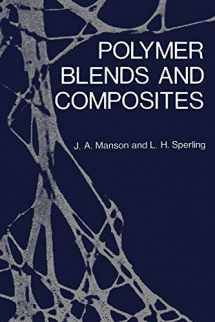
Polymer Blends and Composites
ISBN-13:
9781461357100
ISBN-10:
1461357101
Edition:
1976
Author:
John A. Manson
Publication date:
2012
Publisher:
Springer
Format:
Paperback
530 pages
FREE US shipping
Book details
ISBN-13:
9781461357100
ISBN-10:
1461357101
Edition:
1976
Author:
John A. Manson
Publication date:
2012
Publisher:
Springer
Format:
Paperback
530 pages
Summary
Polymer Blends and Composites (ISBN-13: 9781461357100 and ISBN-10: 1461357101), written by authors
John A. Manson, was published by Springer in 2012.
With an overall rating of 3.7 stars, it's a notable title among other
books. You can easily purchase or rent Polymer Blends and Composites (Paperback) from BooksRun,
along with many other new and used
books
and textbooks.
And, if you're looking to sell your copy, our current buyback offer is $0.58.
Description
The need for writing a monograph on polymer blends and composites became apparent during presentation of material on this subject to our advanced polymers class. Although the flood of important research in this area in the past decade has resulted in many symposia, edited collections of papers, reviews, contributions to scientific journals, and patents, apparently no organized presentation in book form has been forthcoming. In a closely connected way, another strong impetus for writing this monograph arose out of our research programs in the Materials Research Center at Lehigh University. As part of this effort, we had naturally compiled hundreds of references and become acquainted with many leaders in the field of blend and composite research. Perhaps the most important concept stressed over and over again is that engineering materials are useful because of their complexity, not in spite of it. Blends and composites are toughened because many modes of resistance to failure are available. Although such multimechanism processes are diffi cult to describe with a unified theory. we have presented available develop ments in juxtaposition with the experimental portions. The arguments somewhat resemble the classical discussion of resonance in organic chemistry, where molecular structures increase in stability as more electronic configura tions become available.


We would LOVE it if you could help us and other readers by reviewing the book
Book review

Congratulations! We have received your book review.
{user}
{createdAt}
by {truncated_author}


